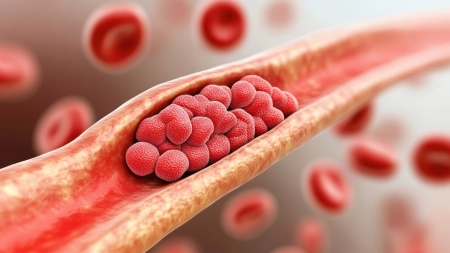Heart bypass surgery – what are the risks?
What is a heart bypass, when is it carried out and what exactly happens in bypass surgery? Read on for the answers to these and other questions on the topic.

What is a heart bypass?
Another word for “bypass” is detour, and that is precisely what a bypass does: it goes around one or more blockages in the coronary arteries. Blood flows through these arteries to the cardiac muscle ensuring that it is supplied with oxygen and necessary nutrients.
During bypass surgery, an artery or vein from the leg, arm or inner chest wall is grafted to the heart in an operation that takes several hours to complete. This blood vessel then assumes the role of the coronary heart artery that has been sealed off. A bypass is like a detour for your blood to use to get around an obstacle.
Why do some people require bypass surgery?
Patients who suffer from the cardiovascular disease “atherosclerosis” or hardening of the arteries can develop a build-up of plaque in the arteries anywhere in their body – including the three main coronary arteries. This causes the inner lining of the affected arteries to narrow in places. This narrowing obstructs the flow of blood to the heart.
If the obstructions in the coronary arteries are very pronounced, the heart is no longer adequately supplied with everything that it needs. This can then result in what are referred to as “angina pectoris” attacks (“tightness in the chest”), particularly during physical exertion. These are pains in the chest that disappear within minutes after a short rest. It also increases the risk of a heart attack.
Bypass surgery can be used to treat this type of disease. The majority of patients are completely free of symptoms after undergoing this procedure.
However, the operation does not actually cure the actual cause of the disease, namely atherosclerosis. That is why it is important to lead a lifestyle that is beneficial for the heart after the procedure so that the bypass continues to function for as long as possible.
What happens during bypass surgery?
The obstructions in the coronary arteries are bypassed using either arteries or veins from the chest wall, the arm or the legs. The best alternative depends on the size and condition of the blood vessels. Only healthy arteries or veins that can be spared at their original location are harvested for a bypass. This means that the supply of blood to this area remains guaranteed even if this blood vessel has been removed.
The cardiac surgeon will first remove the blood vessel that is to be used for the bypass. The internal mammary artery is not removed in its entirety, but merely severed at one end.
The second step consists of connecting this vessel to the affected coronary artery in such a way that it will supply the heart muscle with blood.
The entire procedure takes two to four hours, during which the patient will be under a general anaesthetic. A bypass surgery is usually performed as an open-heart surgery. This means that the breast bone (sternum) is split down the middle and the heart is usually stopped for a short period. While this is happening, a heart-lung bypass machine temporarily takes over the pumping of the heart.
It is also possible to perform the surgery without stopping the heart (off-pump technique) The heart is only immobilised to enable suturing to be carried out where stitches are required. Nowadays, it is also possible to perform minimally invasive operations using keyhole surgery through gaps between the ribs. This means the sternum does not need to be split.
How great is the risk associated with this surgery?
If the procedure is not performed in an emergency, the risk is similar to that of any other major surgery. Complications occur in around one to three out of every 100 patients undergoing this surgery. The cardiac surgeon can use the “Euroscore” to determine each patient’s individual risk.
What happens after the operation?
The patient is then kept in the intensive care unit for one to three days for observation. They will be able to do more with each passing day. Coughing may be painful initially. Painkillers and physiotherapy can help. Patients are usually up and about again after only a few days. However, the sternum needs about four to six weeks to knit back together and regain its stability.
Cardiac rehabilitation is both important and recommended. It can be completed on an outpatient basis at home (up to twelve weeks) or as an inpatient (three to four weeks). The goal is for the patient to regain confidence in their body and physical fitness. Cardiac rehabilitation includes a programme of exercise, counselling, psychological support and tips on how to manage stress. To ensure that the bypass procedure is successful, it is important not to smoke, ideally in the weeks leading up to the procedure, because smoking can affects wounds from healing properly.
How long does a bypass surgery last?
It depends on the type of bypass. When the internal mammary artery is used, more than nine out of ten bypasses are still open and working after ten years. The figure is approximately seven out of ten when veins are used. If a bypass becomes blocked, symptoms similar to those experienced prior to the operation may occur again.
However, cardiovascular disease can progress even if the patient has had a bypass. This is because a bypass operation does not cure the actual cause of the disease, namely atherosclerosis. Although it is not possible to repair existing damage, a lot can be done to slow down its progress.
The most important course of action is maintaining a healthy lifestyle since an unhealthy lifestyle is often the cause of damage to the blood vessels. Plenty of exercise, maintaining a healthy weight, following a Mediterranean diet with lots of vegetables and a good work-life balance are essential. Not smoking is one of the best preventive measures.
The use of preventive medication is also very important. High blood glucose levels in people with diabetes and high blood pressure not only damage the bypass, but also all other arteries in the body. That is why the best way to treat both of these conditions is with medication. Medicines to lower cholesterol reduce inflammation on the inner lining of the arteries and decrease the risk of arterial plaque build-up. Blood thinners prevent blood clots from forming.


